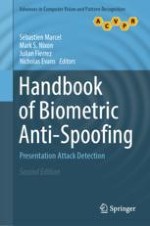2019 | OriginalPaper | Buchkapitel
21. A Legal Perspective on the Relevance of Biometric Presentation Attack Detection (PAD) for Payment Services Under PSDII and the GDPR
verfasst von : Els J. Kindt
Erschienen in: Handbook of Biometric Anti-Spoofing
Aktivieren Sie unsere intelligente Suche, um passende Fachinhalte oder Patente zu finden.
Wählen Sie Textabschnitte aus um mit Künstlicher Intelligenz passenden Patente zu finden. powered by
Markieren Sie Textabschnitte, um KI-gestützt weitere passende Inhalte zu finden. powered by
